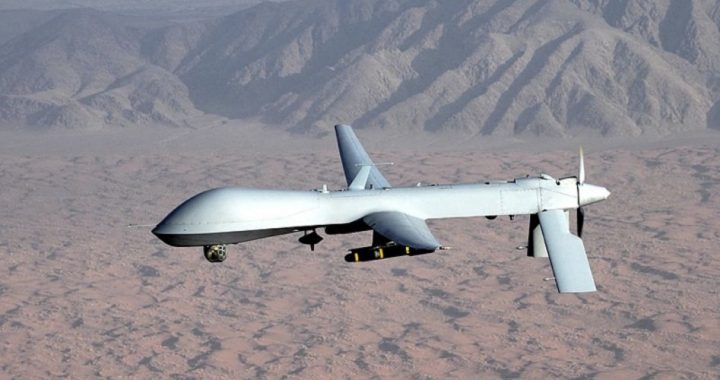
The Department of Homeland Security is positioning itself to assume immense domestic law-enforcement and surveillance powers. From patrolling the traffic on the Internet to consolidating local police power, DHS is accumulating all the unconstitutional authority necessary for a proper Stasi-like secret police force.
A recent story published by California Watch reported that DHS inked a new $443 million deal with über-defense contractor General Atomics to purchase 14 additional Predator drones. If (when) the new craft are delivered to DHS, there would be 24 drones in the agency’s fleet.
As we have chronicled, Predator is the preferred model of unmanned aerial vehicle of the U.S. military for prosecuting its death-by-drone program in Pakistan, Yemen, Afghanistan, and elsewhere overseas. What doesn’t receive nearly as much press is the domestic deployment of these remote control armed spy planes.
DHS is particularly fond of this brand of drone, having spent over $250 million since 2006 on building its Predator fleet. Reportedly, DHS is using the devices to patrol the porous border separating the United States from Mexico.
This new exclusive, exorbitant deal with General Atomics is curious in light of the scathing report on DHS waste issued in June by the Inspector General. As reported by Huffington Post: “The Homeland Security inspector general’s office in a June audit recommended that Customs and Border Protection stop buying the drones until officials figure out a budget plan for the program and how to get the most use out of the unmanned aircraft, which are frequently grounded by inclement weather.”
Specifically, the Inspector General found that the drones were often grounded by harsh weather conditions and were not flying enough to justify the cost on the vehicles’ outrageous price tags. Not to mention the mangling by DHS managers of the flight schedules proposed for the Predators. “CBP has not adequately planned to fund unmanned aircraft-related equipment. As a result of CBP’s insufficient funding approach, future UAS [unmanned aerial systems] missions may have to be curtailed,” the Inspector General’s report states.
This report would seem to signal the death of the DHS drone program, but just in the nick of time, a member of the Congressional Unmanned Systems Caucus rides to the rescue. As reported by cironline:
Rep. Henry Cuellar, D-Texas, who has championed drones as the Democratic co-chairman of the Congressional Unmanned Systems Caucus, said that Customs and Border Protection has to go back to the basics and come up with a sound strategic plan for its drones.
“The first thing any agency should have is a strategic plan. I assumed they had a plan,” said Cuellar. “We have to know where we are going before we start buying any more of the assets.”
Basically, rather than restrict the flow of money to the DHS which would prevent it from purchasing materiel it doesn’t need and shouldn’t have, Cuellar is buying the agency time to develop a plan that will convince congressional budget overseers to loosen the purse strings enough for a new fleet of Predators to fly through.
Never heard of the Congressional Unmanned Systems Caucus? That’s probably the way they like it, but we have some information on the group that is interesting in light of their lobbying on behalf of the drone industry that rakes in so much of taxpayer dollars.
The relationship between drone makers and lawmakers was recently reported by an Arizona radio station:
The drone caucus — like the technology it promotes — is becoming increasingly important in the nation’s capitol as the government looks to unmanned vehicles to help save money on defense, better patrol the country’s borders and provide a new tool to U.S. law enforcement agencies and civilians.
“It’s definitely a powerful caucus,” said Alex Bronstein-Moffly, an analyst with First Street Research Group, a D.C.-based company that analyzes lobbying data.
“It’s probably up there in the more powerful caucuses that sort of is not talked about.” And, he says, caucus members are well placed to influence government spending and regulations.
Congressman Howard P. “Buck” McKeon (R-Calif.) is the co-chair of the caucus along with the aforementioned defender of DHS drones, Henry Cuellar. Notably, McKeon also serves as the chairman of the House Armed Services Committee.
It is noteworthy that the caucus includes eight members of the House Committee on Appropriations, the body that has substantial control over the federal government’s purse strings.
Many of the drone caucus members are supported financially by the industry they endorse. According to Bronstein-Moffly’s data, the 58 drone caucus members received a total of $2.3 million in contributions from political action committees affiliated with drone manufacturers since 2011.
Furthermore, 21 members of the drone caucus represent border states. These congressmen received about $1 million in deposits to their campaign coffers from top large drone makers in the 2010 and 2012 election cycles, according to information reported by the Center for Responsive Politics and analyzed by Fronteras Desk and Investigative Newsource.
For example, General Atomics is among the top three all-time campaign contributors to California Congressmen Brian Bilbray, Ken Calvert, Jerry Lewis, and McKeon.
In 2010 and 2012, General Atomics’ PAC has paid out over $140,000 in donations to drone caucus members representing states located on the border with Mexico.
A PAC largely financed by Northrop Grumman contributed about $150,000 to 16 congressmen in the drone caucus who represent districts in California, Texas, Arizona, and Nevada.
Money. That’s the obvious reason for the drone manufacturers’ siphoning of such significant contributions to the campaign coffers of congressmen, but what would explain the lawmakers’ reciprocation of that devotion?
Power. Cuellar, McKeon, and others of their ilk know that giving the green light to the growth of the domestic fleet of drones patrolling the skies of the homeland, they simultaneously assure that when the time comes every two years to buy air time for campaign commercials touting themselves as the protectors of national security, there will be plenty of money in the campaign’s marketing account to cover the cost of the ad run schedule.
Finally, it is important to remember that DHS isn’t keeping a tight fist around its fleet of never-blinking surveillance devices. And, although DHS can’t seem to keep the drones flying often enough for some advocates, the flight hours are increased by loaning the aircraft to local law enforcement and her fellow federal agencies.
Beginning in 2006, the U.S. Custom and Border Patrol (CBP) began purchasing (as yet) unarmed Predator drones to purportedly aid in securing America’s southern border. According to a report written by the DHS Inspector General, as of the end of 2012, CBP will have 12 of these aircraft in its arsenal with a total cost to taxpayers of nearly $200 million.
Inexplicably, the CBP took delivery of two drones in 2011 and 2012 despite the Inspector General’s statement that “CBP had not adequately planned resources needed to support its current unmanned aircraft inventory.” So, since they weren’t using the drones they already bought, why not buy more? Although that spendthrift attitude is typical of government agency budgeting, perhaps the purchase of Predators is motivated by a goal a bit more sinister than either DHS or the Obama administration is willing to admit.
These other purposes are even hinted at in the DHS report. The tasks being performed by the CBP drones extend well beyond the patrolling of the border and into many other areas, a situation described by one reporter as “mission creep.” Here is a brief catalog of some of the ways CBP is farming out its drone fleet.
CBP Predators have been used to conduct missions for the following federal and state government agencies: U.S. Secret Service, Federal Emergency Management Agency (FEMA), Immigration and Customs Enforcement (ICE); Bureau of Land Management; Federal Bureau of Investigation; Department of Defense; Texas Rangers; U.S. Forest Service; and National Oceanic and Atmospheric Administration (NOAA).
With regard to ICE’s use of the CBP drone, the Inspector General’s report indicates that the aircraft “provided surveillance over a suspected smuggler’s tunnel, which yielded information that, according to an ICE representative, would have required many cars and agents to obtain.” Yes, without the loan-a-drone program, the ICE surveillance mission would have required “many cars and agents,” as well as a warrant. With a drone, the government doesn’t need no stinkin’ warrant.
In a separate report issued in April by the Department of Defense, the Pentagon revealed the locations of over 100 new domestic sites that could soon serve as launch sites for military drones.
The list of present and proposed drone bases includes 39 of the 50 states, as well as Guam and Puerto Rico.
It seems that despite problems with the DHS’s deployment of its drones, one of the high-altitude, high-tech, snoop-and-snipe aircraft may be coming to a town near you.
Joe A. Wolverton, II, J.D. is a correspondent for The New American and travels frequently nationwide speaking on topics of nullification, the NDAA, and the surveillance state. He can be reached at [email protected].



